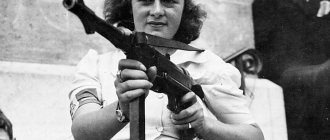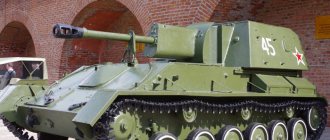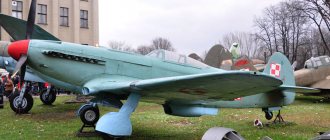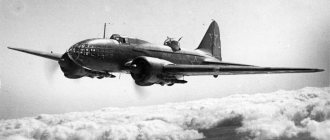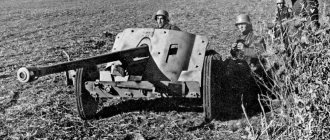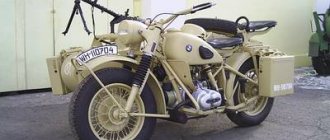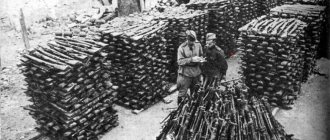The need for mobile weapons
In the 20s of the last century, an urgent need arose in the Red Army for a full-fledged tank machine gun. Work on this project was entrusted to the then unknown gunsmith Georgy Semenovich Shpagin.
Shpagin took the well-proven DP-27 light machine gun as a basis. Considering that the designer did not start the work from scratch, the development process did not take much time. After all, Georgy Semenovich carried out a targeted modernization of the proven design. But still, he did a colossal job. And in 1929, the new machine gun underwent a grueling testing procedure and was adopted by the Red Army. Thanks to the interchangeability and unification of all parts and components of the DP-27 and DT-29, the military industry was able to establish full-fledged production of the new machine gun in a short time. And soon they entered service with almost all tanks and armored vehicles. What’s interesting is this: the T-35 heavy tank and the T-28 medium tank were equipped with 5 DT-29s, which was a record.
The DT-29 machine gun was intended for firing at enemy firing points and infantry. Moreover, both ordinary bullets and armor-piercing bullets could be used against the latter (in case the enemy soldiers were in a protected shelter). Typically, shooting was carried out in short bursts (2-7 rounds each) and at a distance not exceeding 600 meters. If it was intended to stop or inflict maximum damage on some target unprotected by armor (for example, a convoy or foot group), the burst increased by 10-15 rounds. At the same time, the fire was fired at a distance exceeding 600 meters.
Advantages and disadvantages of weapons
The advantages of the Degtyarev machine gun were revealed during testing. The receiving committee noted the ease of use, reliability and rate of fire of the weapon. It was these qualities that made him in demand for the army.
The advantages of DP were also appreciated during combat operations during the Soviet-Finnish and Great Patriotic Wars. The technical characteristics of the weapon made it possible to use it in almost any operation and weather conditions.
However, the design characteristics of the Degtyarev machine gun also have some disadvantages:
- removable bipods on early models - these were often deformed or lost in battle, which reduced the accuracy and ease of shooting;
- overheating of the barrel - replacing it in combat conditions was inconvenient, which did not allow quickly restoring the DP after intense shooting; a similar problem arose with the recoil spring;
- chambers - the first magazines were designed for 49 rounds and were easily deformed, later the patronage decreased to 47, but the weight of the magazine created difficulties for quick reloading.
Despite its shortcomings, the DP has become widespread in infantry formations. Modifications have been developed to allow the machine gun to be used in other branches of the military, including aviation.
Technical part
The automation of the tank machine gun was based on the use of the energy of powder gases, which were diverted from the gun barrel. As for locking, it was carried out by spreading the combat larvae to the sides. The gas regulator played a special role. It added the required performance when shooting in extreme conditions. For example, with increased pollution, dust, excessively high or low temperatures.
Firing in bursts was possible thanks to the firing mechanism. At the same time, as mentioned above, the length of the queue was different. Here, by the way, one of the main advantages of the DT-29 is hidden. Even a poorly trained soldier could handle a machine gun without any problems and fire (if necessary) in bursts of 3-5 rounds. A flag-type fuse was responsible for blocking the parts of the trigger mechanism. A special cone-shaped flame arrester was responsible for masking the flame during shots.
The “Donor” DT-29 was equipped with a bulky and inconvenient magazine with a single-row arrangement of cartridges. The tank machine gun itself received a new disc magazine. In it, the cartridges were folded in 3 rows. And thus it could hold 63 rounds, while remaining more compact than its predecessor. For example, the same DP-27 could accommodate 16 less.
As for the cartridges. For the DT-29, standard rifle cartridges with a light 7.62x54 mm bullet of the 1908 model were used. But if the situation required, the shooter could fill the disc with armor-piercing incendiary, armor-piercing, and tracer bullets.
So that the DT-29 could be placed on a tank, Shpagin created a special ball mount. With its help, it was possible to achieve quick and unhindered aiming of the weapon at the target, both in the horizontal and vertical planes. In addition, the installation ensured reliable fixation of the machine gun in any position. The shooter was reliably protected from enemy bullets and shell fragments by large components of the installation itself. In general, Shpagin managed to bring to life a very successful project.
The DT-29 was aimed at the target with a diopter sight. It was also easily adjustable in any plane. There was, of course, the traditional front sight. It was fixed in a special window of the ball installation. The sight was set at a distance from 400 to 1000 meters (steps of 200 meters). Shpagin provided for everything: for spent cartridges, so that they did not fall inside the tank, a special cartridge catcher made of canvas was attached.
Georgy Semenovich did not ignore the butt. On DP-27 it was made of wood and was immovable. But on the DT-29 the stock was already made metal and retractable. In the position pushed all the way, the machine gun was mounted on a ball mount. And if the need arose, it could easily be disconnected from it.
As for the cost of one machine gun along with a set of spare parts, in 1939 it cost the state 1,400 rubles. Another 23 rubles were spent on the store.
***
If the tank failed during the battle, the crew could fight off the enemy with the help of the DT-29, using it as a light machine gun. Colonel P.N. Tishchenko, who headed the headquarters of the 29th Rifle Corps, recalled: “In June 1941, on the southern outskirts of Vilnius, I added to our headquarters a tankman - a turret gunner from the 5th Tank Division, who could barely drag his feet, but stubbornly continued walk carrying a tank machine gun on his shoulder. He said that the soldiers of the 5th Panzer Division offered stubborn resistance to the enemy as long as they had ammunition and fuel. However, then its crew was forced to blow up the tank, having first removed the machine gun from it.”
The modernization of both machine guns (DP-27 and DT-29) took place in 1944. Restyling affected the design of many parts and components. Therefore, it became possible to produce them using the stamping method. And the return mainspring was relocated to the trigger frame.
After the modernization procedure, the DT-29 received a new name - DTM. And the new product went into production in 1945.
DT-29 - Degtyarev tank machine gun
The history of the DT-29 tank machine gun
(Degtyarev tank) began long before the moment when it was introduced to the leaders of the Red Army back in 1929 under the independent name 7.62-mm tank machine gun of the system designed by Degtyarev of the 1929 model (DT-29). THE USSR. In essence, it was a modernization and refinement of the DP 27 infantry machine gun, adapted for combat work in confined spaces and where all the features of firing a machine gun in the confined space of an armored car or tank were carefully thought out.
DP-27
machine gun, was taken as the basic design, and it was this feature that made it possible to extremely compress the time frame and speed up the creation of a new machine gun for tanks. From its early infantry counterpart, it inherited a trigger mechanism, an automatic operation circuit, a barrel locking system and other main components and assemblies. As required by the leadership of the army and the country, the tank machine gun of the Degtyarev design system had an ammunition supply system, which was supplied from enlarged disk magazines and the barrel was cooled by ambient air.
Immediately after its creation in 1929, the new tank machine gun quickly and successfully passed the next stage of military field tests and inspections, after which it was put into service. Particularly pleasing was the fact that many of the parts and mechanisms of the infantry and tank machine guns were completely interchangeable and easily modernized. Accordingly, the military industry of the USSR was not expensive and did not need additional technologies to launch a full-fledged production of new 7.62 mm tank machine guns. DT-29 machine guns, as practice has shown, were installed on almost all categories of Soviet tanks, including heavy ones. Sometimes one heavy or medium tank, such as the T-35 and T-28, was equipped with not one, but several machine guns, and their number could reach 5 pieces.
In service, the tank machine gun was primarily designed to fire at open or lightly protected firing points and enemy infantry. They shot at the target and destroyed the enemy using ordinary, incendiary or armor-piercing bullets. During the battle, the density of fire was determined by the tank commander or gunner-radio operator by visual observation of the intensity of the battle, the width, depth and nature of the targets being hit, usually in short bursts (2-7 rounds) at an effective range of more than half a kilometer. When firing at enemy unarmored and group targets (columns of enemy vehicles, mounted and foot teams), the distance to which was significantly more than 600 meters, lethal fire was carried out while moving the armored vehicle without stopping, in long machine-gun bursts of 10-15 rounds at once. If the situation allowed and the accuracy of the fire was especially important, shooting was carried out from short stops.
Automatic operation of DT-29
was based on a mechanical scheme that uses the energy of the powder gases of the shot, which are diverted from the barrel along a special path. Locking is done by moving the bolt cylinders in opposite directions. The gas regulator, located in the automation system of this type of weapon, provided undeniable advantages when firing a machine gun in conditions of great dust, pollution and extremely high or, conversely, very low temperatures. The trigger mechanism made it possible to shoot at a target only in bursts. Everything was so simple that even an inexperienced fighter, almost the first time, could hit the enemy from a vehicle in short bursts. For safety purposes, a fuse of a flag design was placed on the machine gun, blocking the movement of the trigger mechanism part when it was on. At the muzzle of the machine gun, in order to reduce the unmasking flame during firing, especially at night, a cone-shaped flame arrester was installed on the muzzle of the barrel, like the DP-27.
In the tank version of the machine gun, instead of a huge magazine with cartridges placed in one row, a new disk magazine for feeding cartridges was used, in which ammunition was placed in 3 rows. It held 16 more rounds than the DT-27 infantry light machine gun and the total number of rounds was 63. Plus, the magazine became much smaller. The cartridges had different bullets - light, which was used for firing from this machine gun, brass or iron cartridges with special bullets (armor-piercing incendiary, explosive, armor-piercing and tracer) could be used.
It was mounted inside the tank on a special ball mount created for it, which provided the fighter with fast and free aiming of the machine gun at the enemy in all directions, and also, if necessary, ensured good fixation of the machine gun in a given position. Additionally, the dimensional parts of the ball mount during combat clashes sufficiently protected soldiers from being hit by shell and bullet fragments. The machine gun's sight
was of a diopter type with adjustment in all planes, and there was also a front sight mounted in a special window of the ball mount. In terms of range, the sight could be adjusted to fire at distances of 400, 600, 800. It was possible to conduct aimed fire even at a kilometer. The spent cartridges did not fall under the feet of the crew, but ended up in a canvas cartridge receptacle, from which they were easy to pour out. The designer also provided for the possibility of removing the machine gun from an armored vehicle so that it could be used as an infantry weapon, for which a special removable bipod was included. The butt was of a prefabricated design and the shooter, if necessary, could make it longer or shorter depending on his needs. When a combat vehicle was hit on the battlefield or simply broke down, the crew could hit the enemy with fire from a DT-29 machine gun, using it as a light machine gun for attack or self-defense.
TTX DT-29:
The barrel caliber was 7.62 mm, the cartridge used was 7.62x54mm. The initial speed of the bullet at the muzzle is 840 m/s. The total maximum length is 1250 mm. The length of the barrel itself is 605 mm. Weight in firing position: approximately 10.5 kg. Technical/combat rate of fire: about 600/120 rounds/min. The disk magazine capacity is maximum 63 rounds. Effective firing range - 1000

